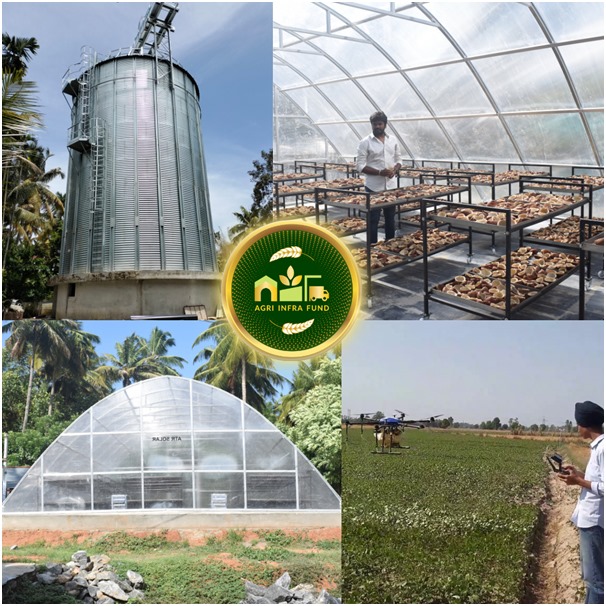India’s agriculture sector, a cornerstone of its economy, affects the livelihoods of over 55% of its population, making it pivotal for national socio-economic development. Despite being the world’s second-largest agricultural producer after China, the sector has faced challenges
 KRC TIMES National Bureau
KRC TIMES National Bureau

India’s agriculture sector, a cornerstone of its economy, affects the livelihoods of over 55% of its population, making it pivotal for national socio-economic development. Despite being the world’s second-largest agricultural producer after China, the sector has faced challenges, particularly in post-harvest management and market accessibility. Recognizing these challenges, the Indian government, under the leadership of Hon. Prime Minister Modi, launched the Agriculture Infrastructure Fund (AIF) in July 2020, aiming to revolutionize the sector by enhancing infrastructure, reducing losses, and promoting innovation.
The objectives of the AIF scheme were clear and compelling: to mobilize medium to long-term debt financing, to enhance farm gate infrastructure, to diminish post-harvest losses, and to drive investment and innovation in the agriculture and allied sectors.
The AIF was not just an investment; it was a commitment to change. With a targeted sanction and disbursement spanning from FY 2020-21 to FY 2025-26, the scheme was designed to offer a blend of financial support mechanisms, including a 3% interest subvention and credit guarantee coverage, thereby laying a fertile ground for growth and development. With an ambitious financial outlay of Rs. One Lakh Crore, the scheme offered interest subvention, credit guarantees, and the convergence of benefits, opening new horizons for farmers, cooperatives, and agricultural entrepreneurs.
As the wheels of the AIF began to turn, the agricultural landscape of India started to witness a remarkable transformation. The fund sanctioned Rs.37,653 Crore for 52,671 projects till February 15th, 2024, while disbursing Rs.23,000 Crores mobilizing an investment of Rs 63,580 Crore in the sector. From the lush fields of Punjab to the vibrant farms of Tamil Nadu, a myriad of projects sprouted, including custom hiring centers, warehouses, and cold storage facilities, each a testament to the country’s commitment to agricultural revitalization. The AIF facilitated the creation of 51,248 post-harvest and community farming assets, including 11,434 Custom Hiring Centres, 11,284 Warehouses, and 1,549 Cold Store projects. This infrastructure development was instrumental in reducing post-harvest losses and improving market accessibility for farmers, contributing to an estimated annual savings of 11 LMT of food grains and a reduction of 2.7 LMT in post-harvest losses of horticulture produce. Further, it is estimated that farmers can get 11-14% more price for their produce due to infrastructure created by AIF.
The impact of the AIF has been profound. In the villages, where the granaries began to fill and the cold storages preserved the fruits of labor, post-harvest losses dwindled. Farmers, armed with better infrastructure, found their produce fetching higher prices, their incomes swelling like the monsoon rivers. The creation of over 5.1 lakh employment opportunities heralded a season of prosperity, sowing the seeds of over 24,000 agri-entrepreneurs.
Behind the scenes, a symphony of strategies played out. The AIF’s online portal became the digital soil where applications germinated and flourished. Awareness campaigns blossomed across social media, while conclaves and exhibitions spread the word far and wide. Each initiative, like a carefully tended crop, contributed to the scheme’s burgeoning success. The AIF portal led to the integration of approximately 0.99 lakh bank branches and has 1.27 lakh registered applicants, the portal stands as a unified platform for beneficiaries, lending institutions, and other vital stakeholders involved in the scheme. It fosters transparency and streamlines the loan application process, ensuring that all parties have access to a smooth, efficient mechanism for their financial interactions.
As the story of the AIF unfolds across India’s agricultural tapestry, it weaves a narrative of hope and progress. The scheme’s legacy, marked by enhanced infrastructure, reduced losses, and empowered farmers, promises a future where agriculture in India is not just a means of survival but a thriving, vibrant sector. And in this future, as the sun rises over the fields, it illuminates a land transformed, a testament to the enduring spirit of India and its farmers, nurtured by the waters of the Agriculture Infrastructure Fund.
Promotional | NE India Writing Star Contest







